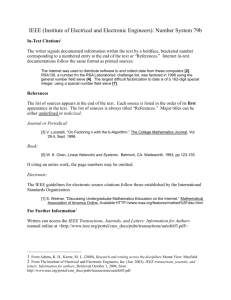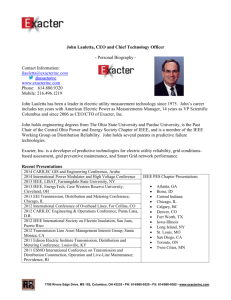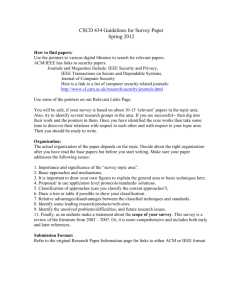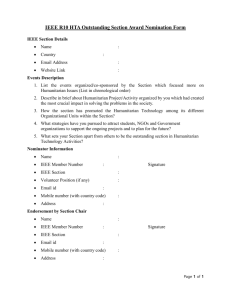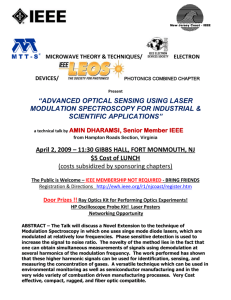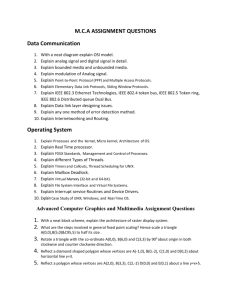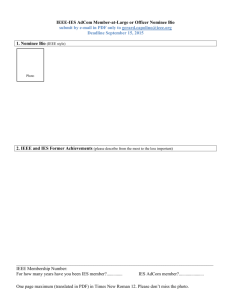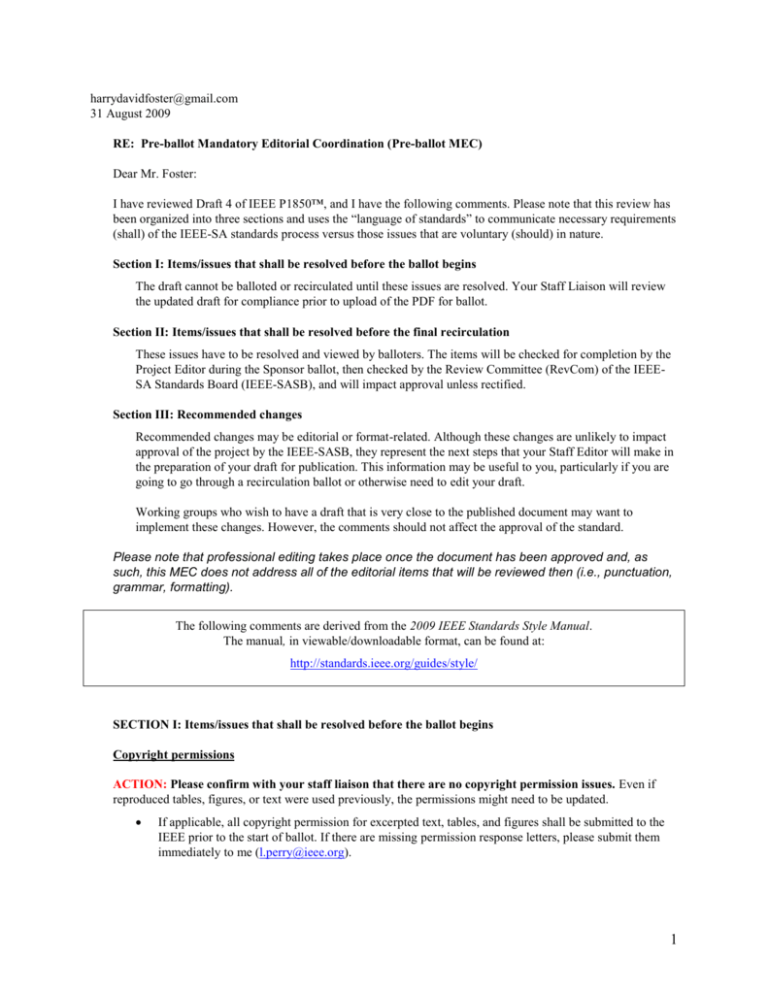
harrydavidfoster@gmail.com
31 August 2009
RE: Pre-ballot Mandatory Editorial Coordination (Pre-ballot MEC)
Dear Mr. Foster:
I have reviewed Draft 4 of IEEE P1850™, and I have the following comments. Please note that this review has
been organized into three sections and uses the “language of standards” to communicate necessary requirements
(shall) of the IEEE-SA standards process versus those issues that are voluntary (should) in nature.
Section I: Items/issues that shall be resolved before the ballot begins
The draft cannot be balloted or recirculated until these issues are resolved. Your Staff Liaison will review
the updated draft for compliance prior to upload of the PDF for ballot.
Section II: Items/issues that shall be resolved before the final recirculation
These issues have to be resolved and viewed by balloters. The items will be checked for completion by the
Project Editor during the Sponsor ballot, then checked by the Review Committee (RevCom) of the IEEESA Standards Board (IEEE-SASB), and will impact approval unless rectified.
Section III: Recommended changes
Recommended changes may be editorial or format-related. Although these changes are unlikely to impact
approval of the project by the IEEE-SASB, they represent the next steps that your Staff Editor will make in
the preparation of your draft for publication. This information may be useful to you, particularly if you are
going to go through a recirculation ballot or otherwise need to edit your draft.
Working groups who wish to have a draft that is very close to the published document may want to
implement these changes. However, the comments should not affect the approval of the standard.
Please note that professional editing takes place once the document has been approved and, as
such, this MEC does not address all of the editorial items that will be reviewed then (i.e., punctuation,
grammar, formatting).
The following comments are derived from the 2009 IEEE Standards Style Manual.
The manual, in viewable/downloadable format, can be found at:
http://standards.ieee.org/guides/style/
SECTION I: Items/issues that shall be resolved before the ballot begins
Copyright permissions
ACTION: Please confirm with your staff liaison that there are no copyright permission issues. Even if
reproduced tables, figures, or text were used previously, the permissions might need to be updated.
If applicable, all copyright permission for excerpted text, tables, and figures shall be submitted to the
IEEE prior to the start of ballot. If there are missing permission response letters, please submit them
immediately to me (l.perry@ieee.org).
1
Prior to sending them to me, please ensure that the following are included in each response letter
you obtain from the copyright owner:
The permission response is on company letterhead (where applicable) or the original email from
the copyright owner should be forwarded to me if the individual is the copyright owner (rather
than a company)
Permission has to be granted
For world rights use of the material in the standard (either modified or unmodified, as
requested by you)
To modify and reprint in all future revisions and editions of the standard
For use in all media known or hereinafter known
If the above information is not included in the response letters sent to you, you will need to
request revised letters from the copyright owner. Please inform me if the copyright owner does
not agree to grant permission for these items.
Sample permission request (for excerpts with and without modifications) and response letters are
available at the following Internet location:
http://standards.ieee.org/guides/style/
Copyright statement
ACTION: Please modify the copyright statement that appears on the first page of the draft.
The correct copyright statement shall appear on the first page of the standard.
Copyright © 2009 by the Institute of Electrical and Electronics Engineers, Inc.
Three Park Avenue
New York, New York 10016-5997, USA
All rights reserved.
This document is an unapproved draft of a proposed IEEE Standard. As such, this document is
subject to change. USE AT YOUR OWN RISK! Because this is an unapproved draft, this
document must not be utilized for any conformance/compliance purposes. Permission is hereby
granted for IEEE Standards Committee participants to reproduce this document for purposes of
international standardization consideration. Prior to adoption of this document, in whole or in part,
by another standards development organization permission must first be obtained from the IEEE
Standards Activities Department (stds.ipr@ieee.org). Other entities seeking permission to
reproduce this document, in whole or in part, must also obtain permission from the IEEE
Standards Activities Department.
IEEE Standards Activities Department
445 Hoes Lane
Piscataway, NJ 08854, USA
ACTION: Please add copyright information to footer of each page.
The correct copyright line shall appear on the bottom of every page, including the body of the
standard:
Copyright © 2009 IEEE. All rights reserved.
This is an unapproved IEEE Standards Draft, subject to change.
2
Draft title
ACTION: Since P1850™ is an unapproved draft, please delete “IEEE” from the title on page 1. Only approved
drafts have the IEEE designation. Please use instead:
Draft Standard for Property Specification Language (PSL)
Scope and Purpose
ACTION: Please change either the PAR or the draft so that the purposes match.
For new and revision projects, the purpose (if included) of the draft standard submitted for ballot shall
match the purpose of the approved PAR.
Please note that additional corrections are listed in Section II and Section III.
SECTION II: Items/issues that shall be resolved before the final recirculation
Trademarks or service marks
ACTION: Please address the use of trademarks in the draft.
ACTION: Does Verilog or System Verilog referred to in Clause 1 require any permissions, copyright
statements, footnotes (see below), etc.? SystemC is footnoted on the copyright page as a registered
trademark, but the text citation does not include the registered trademark symbol.
Trademarks or other proprietary designations that are not commercial equipment or products should be
avoided in standards. If used however, the trademarked name shall be identified in the standard and marked
as such (with either ® or ™), as appropriate, upon first reference. All trademarks shall be credited to the
trademark owner in the front matter of the standard. The following text shall be included in a footnote at
any mention of specific trademark information in the standard:
The following information is given for the convenience of users of this standard and does not
constitute an endorsement by the IEEE of these products. Equivalent products may be used if they
can be shown to lead to the same results.
Registration objects
ACTION: Please address the registration of objects, if applicable.
If the draft contains a registration of objects (for additional information, visit the IEEE Standards Web
site at http://standards.ieee.org/regauth/index.html), the working group shall submit the document to
the IEEE Registration Authority (IEEE-RA) for mandatory coordination (submit to
a.n.weaver@ieee.org for review). The text containing the registration information should be
highlighted in the draft and the clause should be noted in the email. If the working group believes that
the draft may potentially contain a registration of objects or if the working group would like
information about setting up a registration, contact the IEEE-RA as early as possible to prevent a delay
in approval by the IEEE-SA Standards Board.
Front matter − Patents
ACTION: This standard has patent letters of assurance (LoA). The patents paragraph shall be replaced
with the following text:
3
Patents
Attention is called to the possibility that implementation of this standard may require use of subject matter covered
by patent rights. By publication of this standard, no position is taken with respect to the existence or validity of any
patent rights in connection therewith. A patent holder or patent applicant has filed a statement of assurance that it
will grant licenses under these rights without compensation or under reasonable rates, with reasonable terms and
conditions that are demonstrably free of any unfair discrimination to applicants desiring to obtain such licenses.
Other Essential Patent Claims may exist for which a statement of assurance has not been received. The IEEE is not
responsible for identifying Essential Patent Claims for which a license may be required, for conducting inquiries into
the legal validity or scope of Patents Claims, or determining whether any licensing terms or conditions provided in
connection with submission of a Letter of Assurance, if any, or in any licensing agreements are reasonable or nondiscriminatory. Users of this standard are expressly advised that determination of the validity of any patent rights,
and the risk of infringement of such rights, is entirely their own responsibility. Further information may be obtained
from the IEEE Standards Association.
ACTION: Please add the following clauses to the front matter before the Introduction and Patents sections:
Notice to users
Laws and regulations
Users of these documents should consult all applicable laws and regulations. Compliance with the provisions of this
standard does not imply compliance to any applicable regulatory requirements. Implementers of the standard are
responsible for observing or referring to the applicable regulatory requirements. IEEE does not, by the publication of
its standards, intend to urge action that is not in compliance with applicable laws, and these documents may not be
construed as doing so.
Copyrights
This document is copyrighted by the IEEE. It is made available for a wide variety of both public and private uses.
These include both use, by reference, in laws and regulations, and use in private self-regulation, standardization, and
the promotion of engineering practices and methods. By making this document available for use and adoption by
public authorities and private users, the IEEE does not waive any rights in copyright to this document.
Updating of IEEE documents
Users of IEEE standards should be aware that these documents may be superseded at any time by the issuance of
new editions or may be amended from time to time through the issuance of amendments, corrigenda, or errata. An
official IEEE document at any point in time consists of the current edition of the document together with any
amendments, corrigenda, or errata then in effect. In order to determine whether a given document is the current
edition and whether it has been amended through the issuance of amendments, corrigenda, or errata, visit the IEEE
Standards Association Web site at http://ieeexplore.ieee.org/xpl/standards.jsp, or contact the IEEE at the address
listed previously.
For more information about the IEEE Standards Association or the IEEE standards development process, visit the
IEEE-SA Web site at http://standards.ieee.org.
Errata
Errata, if any, for this and all other standards can be accessed at the following URL:
http://standards.ieee.org/reading/ieee/updates/errata/index.html. Users are encouraged to check this URL for errata
periodically.
4
Interpretations
Current interpretations can be accessed at the following URL: http://standards.ieee.org/reading/ieee/interp/
index.html.
Verbs
ACTION: Please review usage of the word "must," which is deprecated and shall not be used when
stating mandatory requirements; must is used only to describe unavoidable situations.
Normative references and bibliography
ACTION: Documents listed in the normative references clause shall also be cited within the body of the
document. If references are not cited normatively, they should be moved to the bibliography (annex).
Normative reference
IEC/IEEE 62142 (IEEE Std
1364.1)
Comments
IEEE Std 1364.1 is cited in text. Please clarify to also
include the IEC standard number.
ACTION: Please update the text that introduces the normative reference clause. (For more information
about references, see 10.4.2 of the 2009 IEEE Standards Style Manual.)
The normative reference clause is introduced with the following paragraph:
“The following referenced documents are indispensable for the application of this document (i.e.,
they must be understood and used, so each referenced document is cited in text and its relationship
to this document is explained). For dated references, only the edition cited applies. For undated
referenced, the latest edition of the referenced document (including any amendments or
corrigenda) applies.”
ACTION: Please list draft numbers and dates in Clause 2 for IEEE P1800 and IEEE P1666. (Page 50 of
the style manual shows a properly cited draft standard.)
ACTION: Because normative references shall be readily available, the working group will need to
provide a copy of IEEE P1800 and IEEE P1666, before final publication, to be archived by IEEE.
Graphics
ACTION: For linked graphics, please supply separate electronic files (preferably TIFF). Separate files
are not needed if figures have been inserted/embedded.
ACTION: If possible, also supply the source files for the graphics to be archived for future updates to the
standard.
Please note that additional corrections to are listed in Section III.
SECTION III: Recommended changes
Definitions
ACTION: Clause 3 definitions shall be in alphabetical order but not numbered (see 10.5 of the 2009 IEEE
Standards Style Manual). The following statement should precede the list of terms and definitions:
5
For the purposes of this document, the following terms and definitions apply. The IEEE Standards
Dictionary: Glossary of Terms & Definitions should be referenced for terms not defined in this
clause.
Table/figure numbering
ACTION: Tables and figures should be referenced in text by the words Table or Figure and their numbers only
(e.g., “see Figure 4”).
Normative references and bibliography
ACTION: Please delete The Authoritative Dictionary of IEEE Standards Terms in the bibliography.
General style
ACTION: All clauses are run-in (i.e., do not start on a new page) unless starting each clause on a right page has
been approved by your IEEE editor.
ACTION: Only one lettered list per subclause (see 5.1.1). Please style lists as lettered, numbered, or dashed.
ACTION: Fonts, font sizes, and styles vary widely in some syntaxes (e.g., Syntax 6-46), NOTES (e.g.,
6.2.1.4.1, courier appears larger), tables (e.g., Tables 4 and 5), figure titles (e.g., Figure 14), and code (e.g.,
A.4.2). Do the variations have different meanings? Please review fonts, font sizes, and styles (bold, italic) for
accuracy.
ACTION: Multiple NOTES in the same subclause should be numbered (e.g., 7.1.2).
ACTION: The IEEE uses dashed lists instead of bulleted lists. See 7.2.3 and Annex B.
ACTION: Annex B is not formatted using IEEE styles; please continue IEEE formatting in Annex B.
ACTION: Indices are discouraged unless the document is very long or complicated (see 10.8 in the 2009 IEEE
Standards Style Manual). As most standards are published in PDF format, the ability to electronically search for
terms makes an index largely unnecessary. Consider deleting the index.
ACTION: Remove all change-bars.
General style
ACTION: For future standards, please use the document template found on the IEEE Standards website, which
contains the correct IEEE copyright notice:
http://standards.ieee.org/resources/development/writing/writinginfo.html
Please note that the following are next steps for this project.
a)
After you have implemented this review, create the pdf that will be used for ballot (remember that the draft
number shall be rolled to reflect that changes have been made to this document, e.g., P1850™/Dx+1).
b) Upon completion of the invitation to ballot, upload the pdf that will be used for ballot to
http://standards.ieee.org/resources/development/balloting/startballot.html.
c)
Note that compliance with items in Section I will be reviewed by the Staff Liaison when you upload the pdf
to the URL in item b). The Project Editor will not review your draft until the Ballot MEC, which occurs
during the Sponsor ballot review.
d) The RevCom MEC will occur after you submit the final balloted draft to RevCom. At that time you will
also be required to submit the document source file. If the figures are not native Word or FrameMaker files,
6
each graphic shall be submitted as a separate file following the requirements outlined in Clause 16 of the
2009 IEEE Standards Style Manual.
Thank you for the opportunity to review this draft. If you have any queries about the comments in this
mandatory editorial coordination, please contact me via email (l.perry@ieee.org).
Best regards,
Lisa Perry
Program Manager, Document Development
IEEE Standards Association
cc: Mike Kipness
7


